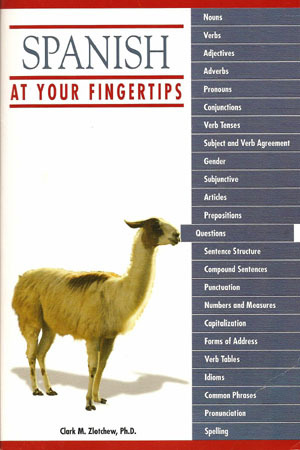Good Reading
 For this old brain of mine — that threatens to retire before I do — a book that makes simple what has always been somewhat complicated to me is a book that I will cherish.
For this old brain of mine — that threatens to retire before I do — a book that makes simple what has always been somewhat complicated to me is a book that I will cherish.
Clark M. Zlotchew, Ph.D., has taught Spanish language at SUNY College at Fredonia in New York State since 1975. He has published more than a dozen books including translations of Spanish poetry and fiction as well as Alpha Teach Yourself Spanish in 24 Hours.
His recently published Spanish at Your Fingertips is well organized, easy to use, a delight to open almost at random while you are waiting in line at a Mexican bank or while you are sipping coffee in your favorite street café in San Francisco or New York City. You do not need to begin at page 1 and study through to page 364.
How does Spanish at Your Fingertips work? Perhaps you are still struggling with por and para (and that includes me and most of my expatriate friends here in southern Mexico). You can turn to Uses of Por and Para, Section 6.3 (which is Chapter 6, Section 3), even using the printed thumb-tabs when you get used to them. Professor Zlotchew has obviously worked very hard to make Spanish easy for his students, which includes us, the readers of his fine new book. Section 6.3 begins with a very condensed summary of the uses of por and para:
- Movement Through a Space: por
- Movement Toward a Space: para
- Cause: por
- Aims: para
- Instrument or Agent: por
- Exchange: por
- For the Sake of/On behalf of: por
- Vague Location: por
- Opinion: para
- Considering the Fact That…: paraBefore describing in detail each of the above uses of por and para, Professor Zlotchew tells us that “Both can often be translated as ‘for’ and, at other times, as ‘by.’ Yet these two Spanish prepositions are in no way interchangeable; each has its own particular use.”Let’s look at the first use listed, Movement Through a Space: por. To understand this, Professor Zlotchew asks us to “imagine an arrow, representing motion, inside or alongside a box. This preposition refers to movement within or alongside a specific space, depending on context.” The examples (generally four of them for each use) are very clear:
- Viajé por México. I traveled through Mexico.
- Caminaba por la calle. He/she was walking down the street. But what if you are talking about Movement Toward a Space: para? Then you conceptualize this concept “as an arrow moving toward a box. Para represents movement toward a specific space, in the direction of that space.” For example: Me voy para España. I’m leaving for Spain. Salió para la oficina. He left for the office.Or Aims: para? This use “looks to the future. It could be translated as ‘Why?,’ but it would be more apt to translate it as ‘What for?’ or ‘For What?’ The point is, ‘¿Para qué?’ asks for goals, purpose, aims. It asks about what box the arrow is aiming at.” For example:
- ¿Para qué trabajas? Why (toward what goal) do you work?
- Trabajo para vivir. I work in order to live.Another use that has confused me and that is now clear is Vague Location: por. “You can conceptualize this as an arrow sweeping in a circular movement around the inside of the box.” For example:
- Esa casa está por aquí. That house is around here somewhere.
- Lo dejé por allá. I left it somewhere out there.
- Viven por acá. They live (somewhere) around here.Well, at any rate, many readers of Mexico Connect have struggled with por and para. Now, after a few minutes spent studying Spanish at Your Fingertips, you can use por and para with confidence.I have illustrated the structure of Professor Zlotchew’s book using only a few examples out of one sub-section of one chapter. The other chapters are:
- 1. Pronunciation,
- 2. Time, Date, and Other Numbers,
- 3. Noun and Articles,
- 4. Pronouns,
- 5. Descriptors: Adjectives, Nouns, and Adverbs,
- 6. Prepositions (which includes the subsection “Uses of por and para,”
- 7. Verbs: Present Tense, Questions, Negation,
- 8. Verbs: Preterit and Imperfect Past Tenses,
- 9. Verbs: Future and Conditional Tenses,
- 10. Verbs: Present Participle/Progressive Tenses,
- 11. Past Participle/Passive Voice/Compound Tenses,
- 12. Reflexive Verbs,
- 13. Verbs: Present Subjunctive and Commands,
- 14. Verbs: The Imperfect Subjunctive Compound,
- 15. Commonly Confused Verbs/Verbs as Nouns,
- 16. Comparison and Urges/Obligations,
- 17. Adverbs Indicating Location/Demonstratives.
(See anything here that you still need to master?)Each chapter is subdivided so that by looking at the detailed Contents you can easily find what you are looking for. Puzzled by “Reflexive Verbs”? Still trying to figure out what a “reflexive verb” is? Chapter 12, Reflexive Verbs, is sub-divided into three sections:
- 12.1 Reflexive Object Pronouns
- 12.2 The True Reflexive
- 12.3 Reflexive as Reciprocal.
In 12.2 The True Reflexive, Professor Zlotchew explains that “The original and basic function of a reflexive verb is to indicate that the subject of the verb is exactly the same person or thing that is the object of that verb. In other words, the one who performs the action of the verb in question is also the one who receives the action.” Here are some easily understood examples:
- (Yo) me veo. I see myself.
- (Tú) te ves. You see yourself.
- El gato se ve. The cat sees itself.Spanish at Your Fingertips is not a textbook for the beginning student to learn Spanish. It is, though, a fine book for the beginning student as well as the intermediate and advanced to have sitting alongside his or her favorite Spanish-English dictionary. It is a reference book. As such, it includes a Glossary in case you’ve forgotten the meaning of “idiom” or “morpheme” or “reciprocal verb”; it also includes Reference Material in case you need to find Spanish-English/English-Spanish dictionaries for health professional; and it has a good index, something I really insist upon for reference books of this nature.For this old brain of mine — that threatens to retire before I do — a book that makes simple what has always been somewhat complicated to me is a book that I will cherish. In fact, I will not even loan it out to the most beautiful expatriate here at Lake Chapala.
I own at least a dozen books on “how-to-learn Spanish” and I do not want to take the space here to comment on those. I do, though, always have at my fingertips two favorite bilingual dictionaries, The University of Chicago Spanish Dictionary: Spanish-English/English Spanish and The New Revised Velázquez Spanish and English Dictionary. Spanish at Your Fingertips will now takes its place beside those much used references.

